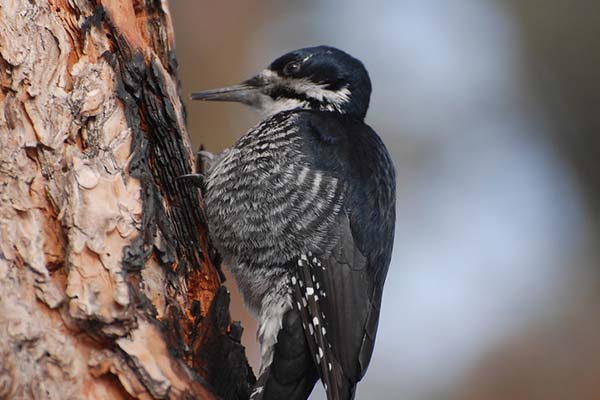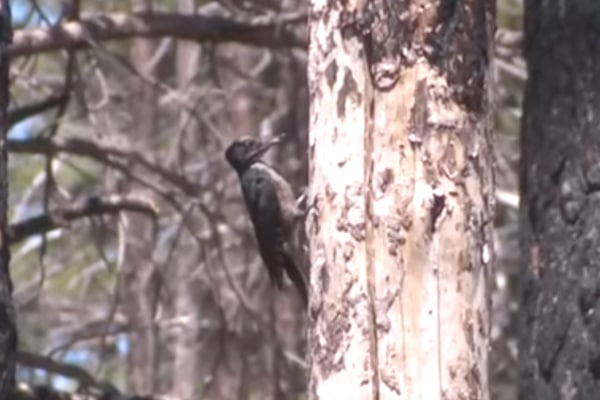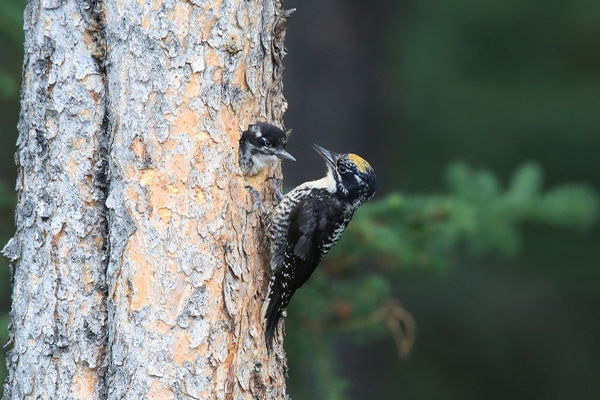Contents
- Black-backed woodpecker facts
- Black-backed woodpecker: how-to identify
- Where You’ll See Black-backed Woodpeckers
- Black-backed woodpecker diet
- Black-backed woodpecker nesting
- Black-backed woodpecker behavior
- How-to attract black-backed woodpeckers
- Black-backed woodpecker threats
- Black-backed woodpecker fun & interesting facts
- Black-backed woodpecker related species in this family
Black-backed Woodpeckers, like the American Three-toed Woodpeckers, are not commonly seen birds despite being louder than the latter. These birds are well-associated with burned forests, mainly because of their ability to locate these forests in just 1-4 weeks after a forest fire.
In this article, we will learn more about Black-backed Woodpeckers. We’ll discuss:
- How to identify them
- Where you’ll find them
- What they eat
- How they nest
- Their behaviors
- How to attract them
- Their conservation status
- Interesting facts
So if you want to learn more about these birds, read on as we go through all bird facts…

Black-backed woodpecker facts
- Common Name: Black-backed Woodpecker
- Scientific Name: Picoides arcticus
- Scientific Family: Picidae
- Life Span: 6-8 years
- Size: 9.1 inches
- Wingspan: 15.8 to 16.5 inches
- Weight: 2.1 to 3.1 oz
- Conservation status: Low Concern
Above Photo Credit: Mike Laycock, National Park Service on Flickr.com
Black-backed woodpecker: how-to identify
Black-backed Woodpeckers are medium-sized woodpeckers with larger heads and longer bills than their bodies. They grow at 9.1 inches in length, 2.1 to 3.1 ounces in weight, and have a wingspan of 15.8 to 16.5 inches.
The birds feature a black and white plumage and their black feathers represent a shade of black ink. These birds have black upperparts from their head, back, wings, and tails and white underparts. Their wings have white spots, their flanks are barred, and their face have a single white malar stripe below their eye.
Differences Between Male & Female
Male and female Black-backed Woodpeckers look very similar to each other, except for only one feature: males have a yellow crown patch that females don’t have.
Differences In Summer Plumage vs Winter Plumage
Black-backed Woodpeckers look the same all year round regardless of the season.
Where You’ll See Black-backed Woodpeckers
Black-backed Woodpeckers are birds species widespread in the northern part of North America. Their range stretch from Alaska to the ends of Canada and some parts of the United States.
These birds are generally found in boreal forests of firs and spruces. Like many woodpecker species, these birds love staying in areas with more dead and dying trees. This includes previously burnt and flooded areas.
Some trees where you can locate Black-backed Woodpeckers include:
- Douglas-fir
- Ponderosa pine
- Spruce
- Fir
- Gemlock
- Aspen
There are times when you’ll find this bird species in unburned forests, too.
Black-backed woodpecker bird migration
Black-backed Woodpeckers are non-migratory birds. However, there are records where they occasionally move further down south in winter, depending on the abundance of food.
Black-backed woodpecker diet
The diet of Black-backed Woodpeckers is composed mostly of insects, mainly those found in tree trunks, including:
- Wood-boring beetle larvae
- Bark beetle larvae
- Darkling beetle larvae
- White-spotted sawyer larvae (composed a large portion of the birds’ diet).
The birds, like many other woodpeckers, find food on trunks and limbs of burned trees. They often just stay on a single spot, pecking through the trunk until they find food. Sometimes, they insert their tongues in the tunnels to reach whatever insect is there.

Black-backed woodpecker nesting
- Clutch Size: 2-6 eggs
- # of Broods: 1 brood
- Incubation Period: 12-14 days
- Nestling Period: 24 days
- Egg Description: White
Black-backed Woodpeckers are monogamous birds. They only breed once every breeding season, but pairs often stay together throughout the year.
These birds excavate their nest cavities around spring, preferably in small, dead trees surrounded by large trees. The cavities are located low, around 10-35 feet off the ground, but will never be higher than 50 feet.
Both parents work together to make the cavity. The males often do the most work at the beginning, while the females do most of the finishing touches. They will then line the cavity with wood chips, where their eggs will sit.
Black-backed woodpecker behavior
Black-backed Woodpeckers are very active birds. They are always flying, looking for burned forests for nesting and sources of food. They generally stay in one area for years, unless they would need to transfer again because resources are gone or declining.
These birds have a wide breeding range. But their territories can either be small or large, depending on the amount of food found in the area. The more there are, the wider the territory they take.
Another thing you should know about these birds is that they have many aggressive calls and postures, particularly in protecting their territories or attracting mates. Among the common displays of aggressiveness shown by these birds are:
- Raising their bills
- Raising their crests
- Swinging their head from side to side
- Spreading their tail and wings
How-to attract black-backed woodpeckers
Black-backed Woodpeckers are secluded birds, mainly staying within their kind. They don’t often stay around areas near human settlements, but if you wish to see them, the first place you can check are burnt forests.
If many dead trees are standing around you, leave them standing as that might help attract these birds. But unless you can meet this requirement, it’s unlikely that Black-backed Woodpeckers would stay there.
They might pass by in search of insects and probably water, so just make sure to provide those. Make your yard more insect-friendly, hang feeders with mealworms, and set up a heated birdbath.
Black-backed woodpecker threats
Black-backed Woodpeckers are species of low concern. Their populations have always been stable, and as long as we don’t clear burnt forests, they will always have habitats for their foraging or nesting.
Black-backed woodpecker fun & interesting facts
- Female Black-backed Woodpeckers forge higher up on trees than males.
- Black-backed Woodpeckers have three toes and are also called the Arctic Three-toed woodpeckers.
- These birds love to forage on charred, blackish tree trunks the most.
- The oldest recorded Black-backed Woodpecker was at least 4 years and 11 months old.
- Williamson’s Sapsucker
- Yellow-bellied Sapsucker
- Red-naped Sapsucker
- Red-breasted Sapsucker
- Lewis’s Woodpecker
- Acron Woodpecker
- Gila Woodpecker
- Golden-fronted Woodpecker
- Red-bellied Woodpecker
- American Three-toed Woodpecker
- Black-beaded Woodpecker
- Downy Woodpecker
- Nuttall’s Woodpecker
- Red-headed Woodpecker
- Ladder-backed Woodpecker
- Hairy Woodpecker
- White-headed Woodpecker
- Arizona Woodpecker
- Ivory-billed Woodpecker
- Pileated Woodpecker
- Northern Flicker
- Gilded Flicker

